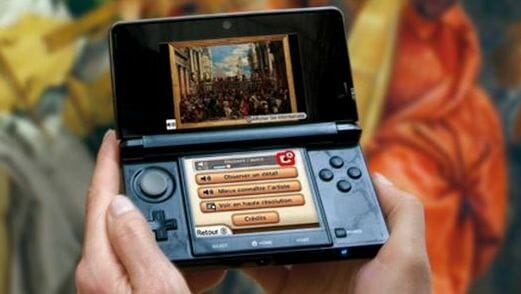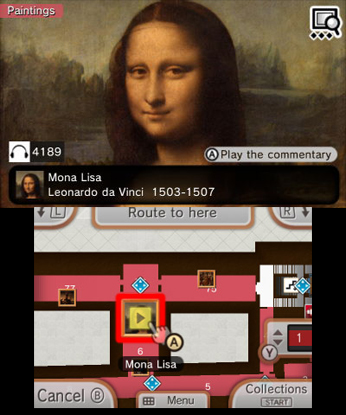
The last month of 2013 was a loud, dreary affair. Amidst all the sturm und drang of year-end Best Ever lists, not to mention the rumble of next-generation consoles still bustling out of their respective gates, it was easy to miss a quiet release on the year’s most successful console. Nintendo 3DS Guide: Louvre is a piece of downloadable software that replicates for home-use the same interactive guide available for rent at the famed Parisian museum. While its competitors barked about cloud computing and 1080p resolution, Nintendo released the equivalent of a portable high-school field trip. The surprise here is how successful a dedicated gaming device is at showcasing some of the world’s most treasured pieces of art.
The guide was first available exclusively to visitors starting in spring 2012. This purchasable version has been tweaked, with several options more befitting the At-Home experience. You can still use the interactive map as if you were there, but the interface is a little disorienting. Wandering the giant palace can be a confusing task, as the map was likely designed only as a supplement to being there, in person; sensors installed throughout the museum talk to your rented 3DS system and show you where you are, GPS-style. But in my apartment outside of Boston, no hazy blue dot lights my way. Still, the ability to poke around an overhead view of each floor gave a touch of verisimilitude to my long-distance appreciation.
Once you choose a piece of art, you can play the audio track(s) paired with it while viewing the work from multiple perspectives. Simple information annotates the piece, such as time period or artist. I do wish a more extensive text was available for each item, as important details are left to be gleaned from the commentary.
The museum itself is one of the art pieces to be admired, as evidenced by dozens of 3D photographs and audio tracks about the history of and architecture of the building. The arrangement and curation of pieces is as much a part of roaming a museum as each individual work. Knowing this, specific “tours” have been built to help one progress through the space without getting lost, while still providing a semblance of moving through this grand space, and not simply cherry-picking known masterpieces.

Oh, you can do that, too—just take the “Masterpieces Tour,” which focuses on the most renowned pieces at the Louvre. Though featuring only three works, the sequence takes fifty minutes, telling of the robust amount of content on offer here.
If you’d prefer to browse art as if perusing your iTunes library, just click “Look at Artworks.” All 489 selected pieces are at your disposal, filtered by medium or title. Some paintings provide high-definition up-close versions, suitable for zooming in and seeing if, yes, Ms. Lisa had a faint trace of a smile on her lips. Chosen sculptures are visible as full three-dimensional models, a perfect match for the 3DS’s native feature. Unfortunately only five such 3D sculptures are available. Cross your fingers for DLC.
One of the more interesting, unexpected virtues of Nintendo 3DS Guide: Louvre is its treatment of the mundane and everyday. While exploring the museum’s overhead map, clicking recognizable icons will bring up information and 3D photos of useful, if pedestrian, aspects of any tourist destination. The Information Desk is a handsome, round circle cut from pale stone: Without its needed computer monitors and pamphlet holders, one might mistake it for 14th century Islamic ceramics. (Real artifacts of that time and place are just one room over, in the basement section of the Denon wing.)
Each section includes a half-dozen 3D photos of the space itself, providing each series of displays with a context impossible to gather from a simple line-up of favorites as would be found in a book. A ceremonial ivory dagger, its hilt a horse’s head with jewels for eyes, is certainly worth investigation; so, too, is the nearest WC (restroom). Click on the telltale Man/Woman icon and sure enough, prepare to be graced with a 3D image of a heavy brown door, its silver handle casting a shadow on the burnished entrance, the dusty tile floor no less instrumental in explaining its era’s virtues than Artemis from Philomelium, a sculpture of the Greek goddess of war, describes the interests of 2nd century Asia Minor.
In the Land of Videogames, 2013 will be remembered for two shiny new boxes with numerical names. Nintendo, to the chagrin of those who expect pomp and bluster from their game-makers, continued to nonchalantly produce things for people living outside of those boxes. Nintendo 3DS Guide: Louvre is but the latest example, packing in a trove of culture and history that makes you, and its host device, immeasurably smarter. Sounds like a new year’s resolution to me.
Nintendo 3DS Guide: Louvre was designed and published by Nintendo. It is available for the 3DS.
Jon Irwin is a writer and teacher living in Boston whose work has appeared in Alimentum, Billboard, GamePro, Kill Screen and Paracinema, among other fine publications. Follow him on Twitter, but don’t follow him home.